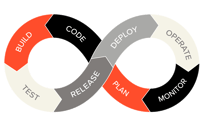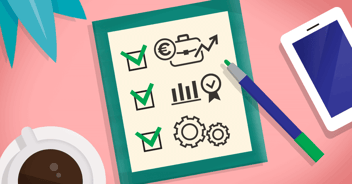The release of the first version of a digital service also kicks off its maintenance and life cycle management. The task of maintenance is to make sure that the service is available, that any faults are quickly fixed, that possible changes are well-managed, and that the service develops hand-in-hand with the needs of the business.
Today, there seems to be no escaping DevOps. Changing to a DevOps model narrows the gap between the project and maintenance phases. However, ensuring maintenance can operate under proper conditions takes some active planning and hard work.
 Process according to DevOps
Process according to DevOps
Architecture and Code Designed for Maintenance
It all starts at the beginning of a project: how should the digital service be designed and built, exactly? When designing the architecture of a service, monolithic environments should be avoided, and the environment should be made self-repairing. At this stage, it makes sense to configure and automate any monitoring and capacity management as much as possible. If the service is a piece of fully customized software, already the first lines of code need to be written with maintenance in mind. Is the code self-explanatory, or does understanding it require several days of work?
Ask your digital service partner: how do you prepare for eventual maintenance during the design phase of the service?
A Stable but Scalable Maintenance Team
Typically the talents who initially take on the development project aren’t available during the maintenance phase of the service. That’s why it’s crucial to properly onboard the team responsible for project maintenance early on. Whenever possible, continuous service experts should already be engaged during the project's development phase to ensure the future maintenance of the code and to take care of the creation and updation of documentation. Investing a bit more money at the beginning of the project will pay for itself once the service is actually deployed!
Once the day-to-day service begins, the maintenance team often has many other customers to take care of. At this point, it’s important to ensure that the team is well-functioning and that any data transfers are carried out so that the responsibility for running the service never falls on a single individual. Once the service enters a more intense development phase (the term often used is continuous development), developers are also needed. Having a team-based maintenance crew ensures that talents stay happy, competencies are scalable, and that development can be amped up if necessary. All these benefit not only the client, but the partner as well.
Ask your digital service partner: how do you organize the work of teams responsible for continuous service and continuous development?
Content of the Maintenance Service
The best maintenance service serves the needs of both the client and the partner: it’s not too narrow and not too broad. Entering into a continuous service agreement creates a long partnership in which both parties must be happy with the content and model of the cooperation.
The service needs to be clearly packaged to outline the responsibilities between the client and the partner to a sufficient degree. Having clear guidelines and processes for incidents help to ease any friction that is bound to arise when faults occur.
Maintenance is also pre-emptive care: it ensures that there’s enough capacity and that the code stays fresh and updated. An annual clock is used to ensure that any necessary updates are done in due time and that the biggest holes in the code are filled even before they cause any problems.
Taking sustainability and carbon footprint into account in the design of digital services is becoming increasingly common. This means that the maintenance of the service aims to not only minimize costs, but also the service's carbon footprint.
And since business needs are ever-changing, the maintenance service needs to be scalable in both directions. Agreement models that are too long or rigid do not serve anyone’s interest – in other words, having the right amount of flexibility is key.
Ask your digital service partner: what will happen when something happens?
Interested?
If you feel like you need help figuring out how to maintain your digital service, book an appointment directly via my calendar. I’m more than happy to give you my two cents on the type of continuous service content and cooperation model I think would be perfect for your business at this time.



